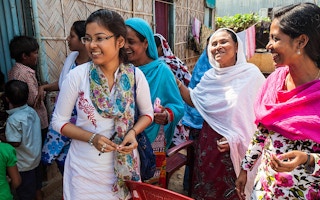At the current rate of progress, it will take more than 200 years to achieve gender equality and female empowerment at work. In many countries, girls are still forced to marry young, which limits their access to education and future employment opportunities. In Niger, for example, in 2016, 76 per cent of girls aged 15-19 were married, which partly explains why 73 per cent of lower-secondary-school-age girls are out of school. Child labor is also common, and almost a third of the world’s women believe that domestic violence is a justifiable punishment under certain circumstances, such as burning meals.
What does it say about human values when it is considered more acceptable to beat a woman than to ruin dinner?
Legal frameworks enshrine such values. Today, ten countries still allow marital rape, and nine permit rapists to avoid punishment by marrying their victims. And, for many more women, such values inform social arrangements that deny them opportunities. Around the world, the absence of paid maternity leave, childcare facilities, or family-friendly job policies prevents women’s participation in the formal economy. Even when women do manage to have a career, they still assume three-quarters of household responsibilities.
Clearly, a more equal, gender-inclusive world will require far-reaching change: in perceptions, attitudes, stereotypes, and laws. Promoting such change is justified not only on moral grounds, but also in economic terms. According to our estimates, if countries eliminated gender-based discrimination and granted women greater access to education and jobs, global GDP would increase by $6 trillion over the next decade. But while the rationale for change may be strong, countries often struggle to develop gender-based policies rooted in solid data and evidence.
“
The absence of paid maternity leave, childcare facilities, or family-friendly job policies prevents women’s participation in the formal economy.
To address this gap, in 2009 the Organization for Economic Cooperation and Development (OECD) developed the Social Institutions and Gender Index with data for some 180 countries. Together with the SIGI Policy Simulator, which launched this year, governments can assess how inclusive their gender policies are, identify areas for reform, and evaluate the programs they implement.
The data have already yielded important insights. Consider Germany. Although the country ranks high on world gender-equality indexes, SIGI shows that it could enter the top ten with a relatively simple change: legally mandating equal pay for equal work. The absence of such a requirement costs Germany the equivalent of 1 per cent of GDP, according to estimates calculated from the most recent OECD Economic Outlook.
In Chile, granting married women the same property rights as married men would increase total investment by 1 per cent. In Vietnam, helping women access the same professional opportunities as men would increase labor-force participation by 1 per cent.
In many countries, only mothers are entitled to parental leave. But this reinforces the perception that unpaid care work is a woman’s job, which in turn skews the distribution of domestic duties. Women in Pakistan and India spend, on average, ten times longer on housework than men do, which means less time engaging in market-related activities, studying, or simply relaxing. Nor is this trend unique to South Asia.
So how can governments use SIGI to change laws and advance gender equality? The best way is to learn from the experiences of others. In South Africa, the Recognition of Customary Marriages Act of 1998, combined with the 2006 Civil Union Act, have effectively eliminated forced and child marriage. In Liberia, a law passed in 2015 entitles women to receive equal pay for equal work. In 2000, Ethiopia repealed language that gave only men the right to administer family assets. In 2015, Bulgaria eliminated male-only professions. And in 2002, Sweden sought to help balance childcare responsibilities between parents by increasing the “father’s quota” in the parental leave law from one month to two.
Data and planning made these initiatives possible, and the OECD’s new datasets are designed to help other countries follow suit. Armed with information, leaders can turn rhetoric about gender equality and empowerment into meaningful action. Ultimately, such action will help to create environments of equality for both women and men, and to build sustainable, respectful, and peaceful societies for all of us. We now have the data to help women fulfill their potential—and to see what happens to all of us when we fail to do so.
Mario Pezzini is Director of the Development Center at the Organization for Economic Cooperation and Development (OECD) and Special Adviser to the OECD Secretary-General on Development and Gabriela Ramos is leader of the OECD Gender Strategy.
Copyright: Project Syndicate, 2018.
www.project-syndicate.org












